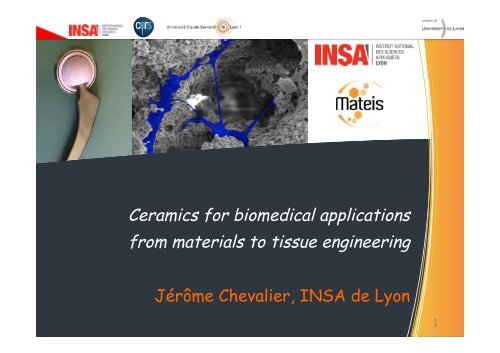Jérôme Chevalier INSA de Lyon
RTy98a
RTy98a
You also want an ePaper? Increase the reach of your titles
YUMPU automatically turns print PDFs into web optimized ePapers that Google loves.
Ceramics for biomedical applications<br />
from materials to tissue engineering<br />
<strong>Jérôme</strong> <strong>Chevalier</strong>, <strong>INSA</strong> <strong>de</strong> <strong>Lyon</strong><br />
1
OUTLINE<br />
- Introduction and context: an aging population, with hopes for<br />
a better life.<br />
- The place of biomaterials (and ceramics) in medical <strong>de</strong>vices.<br />
- Engineering with ceramics: orthopaedic <strong>de</strong>vices.<br />
- Towards bioactive medical systems and tissue engineering :<br />
Calcium phosphate ceramics for bone regeneration.<br />
2
Introduction and context<br />
An aging population in European countries (ex. Germany) <br />
- Number of Hip Replacement Surgery : about 1 Million/year in Europe,<br />
- Osteoporosis : 50% of women (15% of the population above 50 y),<br />
- 30 Millions of persons are suffering back pain : 150.000 invasive<br />
fusion surgeries per year.
Introduction and context<br />
The place of biomaterials (ceramics) in medical <strong>de</strong>vices
Introduction and context<br />
A continuous <strong>de</strong>mand for long-lasting implants<br />
A trend towards tissue regeneration (tissue engineering)<br />
Materials and Biological Engineering<br />
Regenerate<br />
Repair<br />
Number of THRs per year in Swe<strong>de</strong>n
Engineering with ceramics: orthopaedics<br />
‘Bio-inert’ ceramics for hip (knee) joint prosthesis applications<br />
specifications<br />
Bio-mechanical loads (4-10 KN): need for crack resistance<br />
Wear (2 Mc/y): need for wear resistance<br />
Ceramic head<br />
PE or ceramic cup<br />
Body fluid : need for long term stability, 15<br />
(today) or even 30 years (future generations,<br />
young patients)<br />
(pH 5.5 - 7.4, Proteins, Cells)<br />
Current lifetime :<br />
15 years, revision surgery : up to 100.000€, 1-3% <strong>de</strong>ath
Engineering with ceramics: orthopaedics<br />
Main advantage of ceramics : low wear rate<br />
Multifactorial issue : ex : wear <strong>de</strong>bris inflammation osteolysis Asceptic looseing<br />
1990 <br />
2002 <br />
Aseptic Loosening : by far<br />
the main cause of revision<br />
Problems with Polyethylene<br />
Very strong issues with metals
Engineering with ceramics: orthopaedics<br />
Main advantage of ceramics : low wear rate<br />
‘’Hip Simulators’ :<br />
Predict wear rates in vitro with relevant tests<br />
‘’Cell-<strong>de</strong>bris interactions’ :<br />
Un<strong>de</strong>rstand the role of <strong>de</strong>bris on loosening
Engineering with ceramics: orthopaedics<br />
- Fracture of ceramics has been wi<strong>de</strong>ly discussed (over-emphasized)<br />
- Other components may fracture (fatigue of metal)!<br />
- Fracture rates are becoming very rare (
Engineering with ceramics: orthopaedics<br />
A challenge : tougher, stronger ceramics for orthopaedic implants<br />
Opening the door to new medical <strong>de</strong>vices<br />
Phase transformation toughening<br />
Giving some ‘plasticity’ to ceramics ! <br />
Load (N)<br />
500<br />
450<br />
400<br />
350<br />
300<br />
250<br />
200<br />
150<br />
100<br />
50<br />
Bi-axial bending<br />
- Strengthening (1000 MPa) by :<br />
Decrease of grain size<br />
- Toughening (20 MPa.m 1/2 ) by :<br />
Phase transformation toughening<br />
Crack <strong>de</strong>flection and bridging<br />
0<br />
0 20 40 60 80 100 120<br />
Displacement (microns)<br />
! ! !
Engineering with ceramics: orthopaedics<br />
A new inter-vertebral spine prosthesis<br />
(mechanics, materials, physics, chemistry, tissue interactions)<br />
!
Engineering with ceramics: orthopaedics<br />
Surface functionalization as a trigger of bone integration<br />
Mechanical anchoring Laser patterning<br />
Self Assembly Monolayers<br />
(SAMS) – (silanisation)<br />
without<br />
with
Biactive ceramics and tissue engineering<br />
Towards bone regeneration ?<br />
• Extracellular Matrix <br />
10% water <br />
25% organic material <br />
o Collagen <br />
o Growth factors <br />
65% Mineral part <br />
o Calcium Phosphate (ceramic!) <br />
Ca 10 (PO 4 ) 6 (OH) 2 <br />
Ceramic engineers are able to synthesise<br />
Hydroxyapatite pow<strong>de</strong>rs<br />
13
Biactive ceramics and tissue engineering<br />
60% of Hip prostheses are coated<br />
with Hydroxyapatite
Biactive ceramics and tissue engineering<br />
Mixing CaP granules with bone fragments<br />
Bone marrow sampling<br />
Mixing<br />
Implantation : bone volume increase,<br />
trigger bone growth
Biactive ceramics and tissue engineering<br />
Current trends : CaP cements – Additive manufacturing<br />
Additive manufacturing of composite scaffolds (ex. HAP + Collagen)<br />
+ Cells<br />
is a realistic challenge<br />
60j
Biactive ceramics and tissue engineering<br />
Bone tissue engineering : creating bone with biomaterials<br />
BMP2 <br />
TGFβ <br />
Growth factors <br />
Adhesion proteins <br />
RGD Sequence
Thank you !<br />
Jerome.chevalier@insa-lyon.fr<br />
18


